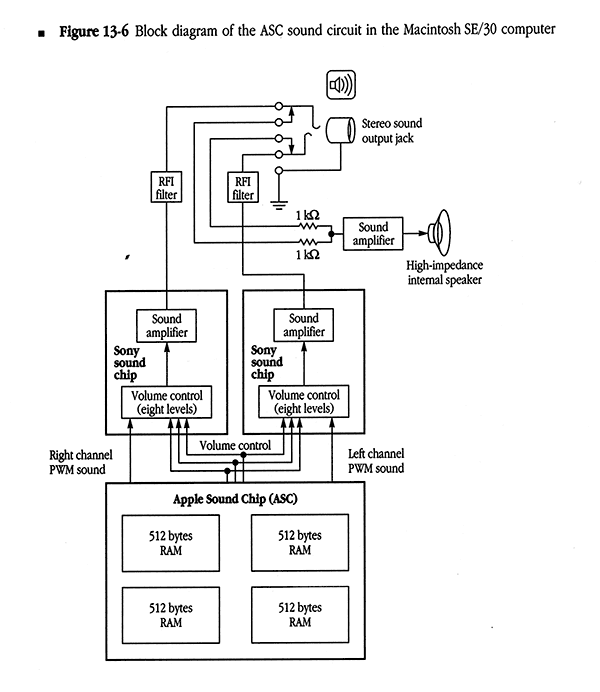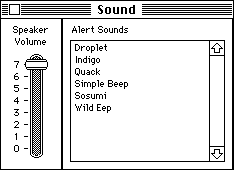SE/30 Forever
< Back to homeSound
Sound is emitted on the SE/30 from a single, built-in 32-ohm speaker mounted within the front bezel. The speaker is secured in place using small plastic mounts, these can be broken off with a knife and replaced with hot glue during reassembly.
The SE/30 has an Apple custom IC, the Apple Sound Chip (ASC), plus two Sony sound ICs which provide the sound capability of the machine. The ASC has four 512-byte buffers of its own, so the SE/30 does not use system RAM for storing sound values. Although the data bus to the ASC is only 8 bits wide, the dynamic bus sizing feature of the 68030 processor allows the sound driver to send longword (32-bit) data to the buffers. The CPU automatically performs four 1-byte accesses to the buffer and increments the addresses appropriately to accomplish the longword transfer.
History
The Apple Sound Chip (ASC) was an ambitious project for one engineer. The ASC was fabricated in a double metal single polysilicon process and was the first chip at Apple to use VLSI Technology’s standard cell methodology as well as their new off‐the‐shelf SRAM compiler tool.
Read more about the creation of the ASC by Pete Foley, a former principal hardware architect at Apple.
The ASC can generate monophonic sound practiaclly indistinguishable from that produced by the sound hardware in the Macintosh SE, Plus, 512K and 128K. The ASC also provides functionality missing from those models, including four independent channels that it can synthesize into monophonic or stereophonic sound. The features of the ASC are made available through the Macintosh Sound Manager.
The hardware of the Macintosh ASC sound system consists of these hardware components:
- the digital Apple Sound Chip CASC)
- two analog sound processing chips Cthe Sony sound chips)
- an internal speaker
- an external stereo mini-phonejack
The ASC has its own data buffers and implements in hardware many of the functions carried out by ROM code in the Macintosh Plus and Macintosh SE computers.
ASC sound system
The Macintosh ASC sound circuit uses an Apple custom IC called the Apple Sound Chip CASC). The ASC is compatible with software written for Macintosh models that use the PWM sound circuit, and also offers stereo sound and other enhancements not available in those computers. The Macintosh models that use ASC sound are
- Macintosh SE/30
- Macintosh Portable
- Macintosh II
- Macintosh IIx
- Macintosh IIcx
- Macintosh IIci
- Macintosh IIfx
The hardware of the Macintosh ASC sound system consists of these hardware components:
- the digital Apple Sound Chip CASC)
- two analog sound processing chips (the Sony sound chips)
- an internal speaker
- an external stereo mini-phonejack
The ASC has its own data buffers and implements in hardware many of the functions carried out by ROM code in the Macintosh Plus.and Macintosh SE computers.
Note: Unlike the Macintosh computers that use the PWM, Macintosh computers that use the ASC do not generate speed-control signals for single-Sided floppy disk drives; therefore, those computers do not store disk-speed control information in their sound buffers.
ASC sound modes
The ASC contains 2 KB of RAM that can be configured as either two 1 KB sound buffers or as four 512-byte sound buffers. The AS~ can operate in any of four functional modes:
- Monaural single-voice mode. The on-board RAM is configured as two 1 KB buffers. The output of the left-channel buffer is converted to a PWM signal and fed to both channels.
- Stereo single-voice mode. The on-board RAM is configured as two 1 KB buffers. The output of each buffer is converted into a PWM signal; one is sent to the left channel and the other is sent to the right channel.
- Monaural four-voice synthesis mode. The on-board RAM is configured as four independent 512-byte buffers. At each sample clock period, a sound value is taken from each of the four buffers, all four values are summed, and the result is converted to a PWM signal and output to both channels.
- Stereo four-voice synthesis mode. The on-board RAM is configured as four independent 512-byte buffers. At each sample clock period, a sound value is taken from each of the four buffers, the values are summed in pairs, and the result of each summed pair is converted to a PWM signal. One of the PWM signals is output to the right channel al)d the other is sent to the left channel.
Because the ASC uses its internal RAM and performs wavetable sound synthesis in hardware, it requires very little processor time. In addition, ASC sound does not have to be synchronized with the video blanking interval, unlike the PWM sound system used in the classic Macintosh and Macintosh SE computers.
Under control of the Sound Manager, the ASC can sample the values in its RAM at any increment to change the frequency of the output sound. Using every other sample (a sampling interval of 2.0) doubles the frequency of the signal (that is, raises the pitch by one octave). Using every sample twice (a sampling interval of 0.5) halves the frequency of the signal (that is, lowers the pitch by one octave). Through the Sound Manager, you can specify any fixed-point number for the sampling interval. The ASC picks the samples in the RAM locations that fall closest to the selected sampling interval. For example, if the interval is 1.4, the ASC picks samples in RAM locations 1, 3, 4, and 6 (rounding from 1.4, 2.8,4.2, and 5.6). The increments used by the ASC are extremely precise, having a 24-bit resolution.
Generating sounds
The ASC generates a pulse-width~modulated square-wave output similar to that generated by the PWM system used in the Macintosh Plus and Macintosh SE. Every sample period, the ASC generates a pulse for each stereo channel, the width of which depends on the values read from the sound buffers. These trains of pulses are sent to the Sony sound chips, which filter them to produce smoothly varying waveforms. The Sony sound chips adjust the amplitudes of the waveforms according to a 3-bit value from the ASC and send the signals to the internal speaker or the external sound jack.
The useful bandwidth of the Macintosh ASC sound system is approximately 7.5 KHz. The sample rate can be either the compact-disc standard of 44.1 KHz, or 22.255 KHz (the sample rate used by the Macintosh PWM sound system described in the previous section).
The internal 32-ohm, 2.25-inch speaker is driven by a 250 mWpoweramplifier in the Sony sound chip. Sound may be played through the internal speaker, or through the external sound jack. If a plug is inserted in the external sound jack, the internal speaker is disconnected. Mixing the two stereo channels together for the internal speaker is handled differently in different models.
In the Macintosh SE/30, the two channels are added together for the internal speaker and the Sound Manager always operates in stereo mode.
The external sound jack is at standard line level (approximately 1.5 volts peak-to-peak) and its source',impedence is approximately 47 ohms. The jack is capable of driving a headphone load of 8 to 600 ohms, or the input to almost any audio amplifier or amplified speakers. It will not adequately drive a directly connected external speaker. The external sound jack is short-circuit protected.
The ASC can emulate the behavior of the sound hardware of the classic Macintosh and Macintosh SE computers; however, the ASC also provides a variety of features not available in those Macintosh computers. For example, the ASC can generate stereo sound synthesized from two voices per channel, using on-board data buffers.
The ASC sound circuit used in the Macintosh SE/30 is slightly different to the one used in the Macintosh Portable, II, IIx, IIcx, IIfx and IIci. The SE/30 always operates in stereo and the sound circuitry mixes the channels together for the internal speaker.

Adjusting sound volume
Volume is controlled via software, there are no volume buttons on an SE/30 or on any compatible keyboards. The Control Panel built into the Macintosh operating system software offers eight choices (0 through 7) for overall volume control. When the volume control setting is set to 0, the Sound Manager disables sound output and flashes the menu bar instead.

Above: System 6 Sound control panel

Above: System 7 Sound control panel
Boot chime
At succesful boot, the SE/30 plays a startup chime that is built into the ROM.